5.6.7
Survey comparing: extrados of 1955 and 1982 - extrados survey 2000 and
verifies
Being the 1955 survey
without global dimensions, for what concern the extrados curves of the
bridge archivolt, it was only possible to perform the comparing of the
local lengths of the 1955 survey with the calculated lengths of the 1982
survey. Nevertheless, as it has been already exposed, these are the most
reliable dimensions of each survey.
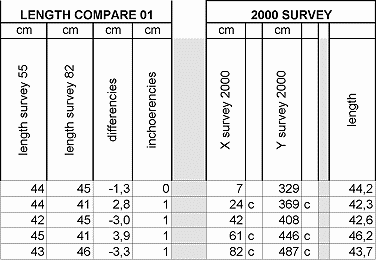
fig.22 - A small portion of
the chart related to the first compare and to the 2000 survey - north
elevation
The chart is here next
detailed explained:
- length local survey 55: is the local
length coming from the 1955 chart
- length survey 82: is the calculated
length coming from the 1982 chart
- differences: are the values (with sign)
of the difference among the previous columns.
- incoherences: gives 1 if the absolute
value of the difference is bigger or equal to 2.5 otherwise it gives 0
The "2000 survey"
is the conventional name here given for the geometry of "the most
likely bridge of Mostar" worked out trough the described procedures.
The 2000 survey is a virtual survey that derives from the analysis and the
study of the available data.
The 2000 survey has been
worked out following the same procedure and same criteria adopted for the
intrados and described at §5.6.5.
The 2000 survey is at the
same time the last step and the result of the numerical analysis, and the
first step towards the design layout; this also because the structural
calculation progression has confirmed that there is no need of making
changes to the bridge geometry most likely layout.
In the extrados curves
there is an exception to the above statement since the ends of the curves
are not part of the survey 2000 but part of the design, and they have
temporary worked out by prosecuting the archivolt shape until the
springers. They may will be redefined after dismantle of the arch stones
near by the springers or may be even not investigated if the dismantle
will not be necessary.
Another compare has been
made to check how the final situation was related to the ancient survey
best data, and this has been done either for the stones lengths, either
for the X,Y co-ordinates of the 1982 surveys, as showed in the following
samples of the charts.
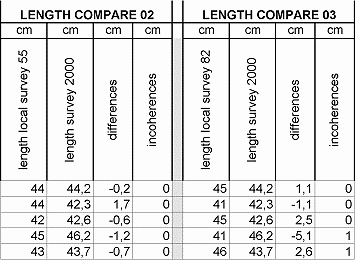
fig.23 - A small portion of
the comparing among 2000 survey and ancient data - north elevation
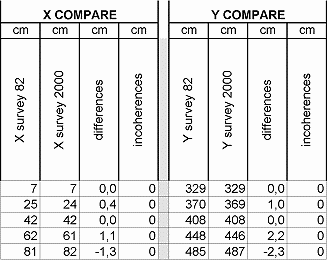
fig.24 - A small portion of
the comparing among 2000 and 1982 survey co-ordinates - north elevation
The 2000 survey is
therefore numerically defined also for what concern the extrados lines of
the north and south side.
5.6.8 2000
survey checks: intrados and extrados comparing charts
Intrados and extrados
length of every single voussoir have been monitored in a special chart,
this because, being very much alike one to each other, it was necessary to
check that no intrados length was higher than the extrados length, to
ensure a correct functioning of the arch structure.
Moreover all the data
concerning the distance among intrados and extrados of every single arch
stone, coming from the 1955 survey, have been filed in the same chart
which is supposed to report all the information concerning the
relationship between intrados and extrados curves.
Here next is reported a
sample of the chart and the explanation of every single column:
- stone number: is a progressive number
which represents the arch stones but could be better referred to the
first joint of each stone (as it is represented in the drawings)
- roman number: is the same numbering
system adopted in the 1955 survey, and it has been maintained to allow
easier checks; it is referred to arch stones (rows)
- distance intrados extrados: is the local
dimension coming from the 1955 survey
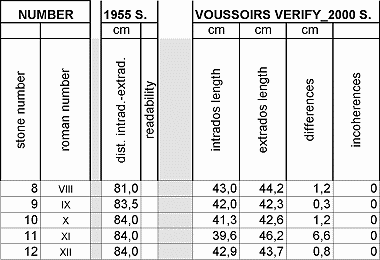
fig.25 - A small portion of
the comparing among intrados and extrados data plus the 1955 survey
distances - north elevation
readability: is a column which is related
to the previous data and may contain the following conventional items:
"?", "c", "x". The first one
("?") means that the value could be hardly readable from the
ancient drawings and for this reason it is not sure; the second one
("c") means that the value has been changed or corrected due
to obvious mistakes; the last one ("x") means that the value
was missing and it has been replaced with a presumable dimension.
intrados length: single stone length
coming from the 2000 survey intrados analysis
extrados length: single stone length
coming from the 2000 survey extrados analysis
differences: extrados length minus the
intrados length
incoherences: gives 0 if the previous
column data is higher or equal to zero, and gives 1 if the previous
column data is lower than zero. A "one" value would represent
a probable error in the previous elaboration of data of the intrados and
extrados curves.
Results coming from this
chart have been encouraging since only a few data had to be checked, and
for differences not lower than cm -1.
5.6.9 2000
survey checks: north-south comparing charts
Another aspect that has
been monitored is related to the differences among the two elevations of
the bridge. This has been performed by shifting all the co-ordinates of
the south elevation to the origin of the north side. This way the X,Y
co-ordinates may be compared for a better monitoring of the irregularities
of the archivolt in its thickness.
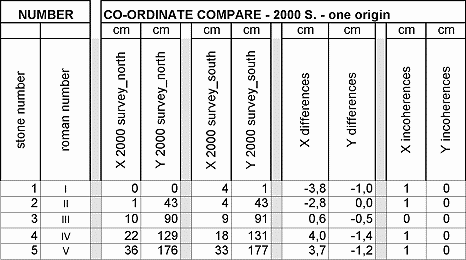
fig.26 - A small portion of
the comparing among north and south co-ordinates - intrados curve
The above chart may be
described as follows:
- stone number: as the other charts
- roman number: as the other charts
- X,Y 2000survey_north/south: co-ordinates
converted to one origin system located in the north-east bridge
springer.
- X,Y differences: differences among north
and south co-ordinates
- X,Y incoherences: gives 1 if the
absolute value of the difference is bigger or equal to 2.5 otherwise
it gives 0
The results of this
comparing chart is that there are remarkable differences among north and
south side, which was expectable, since the north and south span are
different and the archivolt stone layout coming from ancient surveys is
characterised by a variable gradient of row joints. These differences
mostly vary from 5 to 15 centimetres and only in one point they reach
almost 20 centimetres.
For what concern, instead,
the lengths of homologous dimensions belonging to north and south side and
related to the intrados and extrados curves, it may be said that there are
not such remarkable differences as the ones monitored for the X,Y
co-ordinates: the range is from 0.5 centimetres and 3.5 centimetres with
only one case that goes up to 12 centimetres.
Here next there is a sample
of the above mentioned "check chart":
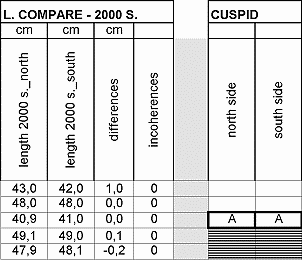
fig.27 - A small portion of
the comparing among north and south lengths and of the cuspids - intrados
curve
- length 2000 s._north/south: intrados
lengths coming from the 2000 survey (the extrados lengths are listed
in a similar chart next to the present one)
- differences: difference between the two
previous columns
- incoherences: gives 1 if the absolute
value of the difference is bigger or equal to 2.5 otherwise it gives 0
The columns of the cusps
analysis (north side and south side) is aimed at a simultaneous monitoring
of the bridge curvature shapes, and represent the results coming from the
centres inquiring mathematical routine (se also §5.9 of this report). On
this subject it may be said that it is possible to find a relationship
among south and north elevation concerning the number and the position of
the cusps.
5.6.10
Numeric analysis chart for the archivolt
For what concern the bridge
archivolt it has been performed a similar numerical inquiry to the other
bridge elements above described. This was mainly aimed at the
determination of the stone dimensions in the thickness of the bridge, to
allow the complete knowledge of the geometry of the load bearing vault.
Among the ancient
documentation, it was available, only for the present case, an additional
survey of unknown origins given to General Engineering by the Conex
company (that was supposed to collect part of the documents related to the
previous condition of the bridge).
This survey has got a
fairly good readability, even if it is only a mosaic of different
photocopies and may not be used as a graphical metrical reference but may
be only remounted taking its written dimensions.
The first part of the chart
contains all the dimensions related to the above mentioned survey:
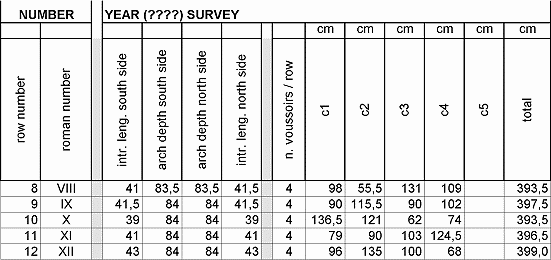
fig.28 - A small portion of
the available data coming from an unknown survey – archivolt analysis
The above chart may be here
detailed explained:
- stone number: as the other charts
- roman number: as the other charts
- intrados length south side: intrados
stone dimension
- arch thickness south side: distance
among intrados and extrados for related arch stone
- intrados length north side: intrados
stone dimension
- arch thickness north side: distance
among intrados and extrados for related arch stone
- number of voussoirs per row: number of
arch stones that are present in the related row
- c1-c5: thickness dimensions of every
single arch stone related to the current row
- total: total amount of c1-c5 values to
check the reliability of the dimensions.
The same procedure followed
in the above chart has been performed for what concern the 1955 survey,
that is here next reported:
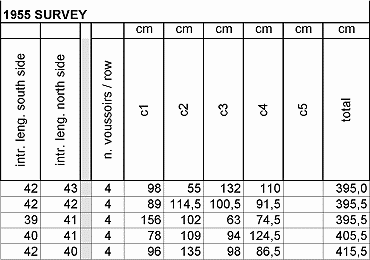
fig.29 - A small portion of
the available data coming from the 1955 survey – archivolt analysis
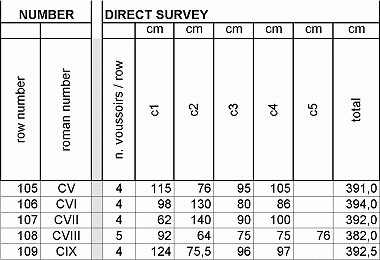
fig.30 - A small portion of
the available data coming from the direct survey – archivolt analysis
Ancient survey data have
been then compared to the direct survey data, as it has been done for the
intrados lengths during the numerical analysis of the curves. This is
shown in the above chart that is structured in a similar way to the
previous ones.
The 1982 survey didn’t
offer a valid support for this purpose, since the intrados view are mainly
projections of the archivolt of a very low readability and where it mostly
seems that some of the joint connections were not documented. The 1982
survey has been used, as in other occasion during this work, to gather the
global dimensions: the bridge thickness, which has been evaluated to be
almost constant, or at least, being the representation scale 1:50 it
couldn’t be possible to determine any remarkable difference or variation
along the whole vault.
Being the available and
listed data very much heterogeneous, it has been performed a first
mediation among the different values, monitoring also the transversal
joint shifts which is an important parameter to be checked to ensure a
good functioning of the masonry structure.
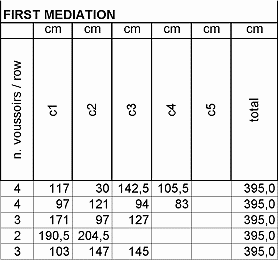
fig.31 - A small portion of
the first mediation on the archivolt data
5.6.11 The
2000 survey and verifies – archivolt
After that it could be
possible to work out the most probable layout of the bridge intrados stone
by stone, determining each stone thickness, which was the only unmonitored
data of the intrados geometry: joints among arch stones rows may be worked
out trough the intrados points.
The survey 2000 of the
stone joints is here next sampled in the following chart:
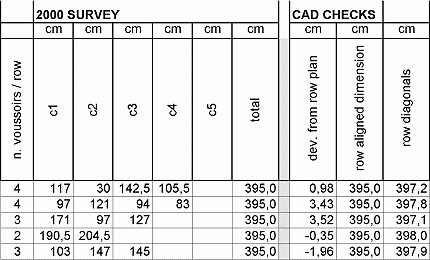
fig.32 - A small portion of
the survey 2000 chart for the archivolt joints and the verify chart
The above chart is
organised as the previous ones and the columns have the same meaning. This
constitutes actually a remarkable result because, even if it has been
worked out from ancient surveys of scarce graphical quality, it has been
checked with some recovered blocks of assembled stones that completely
match the above metric data.
Other checks have been
performed directly in the 3d graphic model of the archivolt carried out in
a CAD system. Those checks are mostly aimed at the stone cut executive
design and will be commented subsequently, anyhow it can be anticipated
what follows:
- deviation from row plan: it represent
how much each intrados row plan doesn’t fit all the related intrados
points
- row aligned dimension: it is the real
dimension of the intrados row joint coming from the 3d co-ordinates
- row diagonal: it is the row diagonal
real dimension coming from the 3d co-ordinates
|